Honolulu’s historical homes have had a rough road to reach that designation. They’ve had to last in an often tough climate for buildings, a very active termite population and the seismic spread of development in the last half a century.
Fortunately a good number of notable residences are still with us, their uniqueness resting on both architectural and historical factors. Certain neighborhoods in Honolulu have more of these than others for various reasons, so we’re taking a look at these in an attempt to bring that history alive as well as spotlight their roles in making each of these communities special.
We’ve included the map below to pinpoint the locations not just of the historic homes covered in this write-up, but of all the officially recognized homes in Honolulu. We hope it will help give a deeper dimension to this residential tour through Old Hawaii.
HAWAII REGISTER OF HISTORIC PLACES – WHAT IT MEANS
The Register is overseen by the State Historic Preservation Division, which falls under Hawaii’s Department of Land & Resources. A Review Board considers submitted nominations once a quarter, which can be not only homes, but government buildings, Native Hawaiian sites or even ‘Malia’, an outrigger canoe carved in 1933, whose form established the template for modern racing canoes.
The board bases recognition on the nominee having at least one of these factors:
1) Association with an important event in state, local, or national history;
2) association with an important person;
3) a good example of a certain style of architecture or the work of an important architect; or
4) likely to yield information about history or prehistory (this would be for an archaeological site).
Many believe that you must maintain a historic home in pristine condition, but there’s actually only the requirement of keeping it in “average” condition – and only if you want to claim the property tax benefit. The tax benefit is an exemption from paying regular property tax rates and only paying the minimum property tax rate of $300 / year (verify), assuming the owner petition to dedicate the property for historic residential preservation and the petition is granted.
It is also possible to make changes to the home or property, thought the alterations have to be reviewed and commented on by the State Historic Property Division. Though that does present limitations on what you can do, it is a better prospect than the ‘No Changes Ever’ that many believe is the policy.
If you’re interested in applying for this recognition or just curious about the process, check out this Guide to Nominating Residences to the Historic Register of Historic Places.
Through this program Hawaii has been able to preserve and protect vital elements of our common history and culture, keeping signposts through our past that show how we arrived at our rich and diverse local way of live.
PACIFIC HEIGHTS
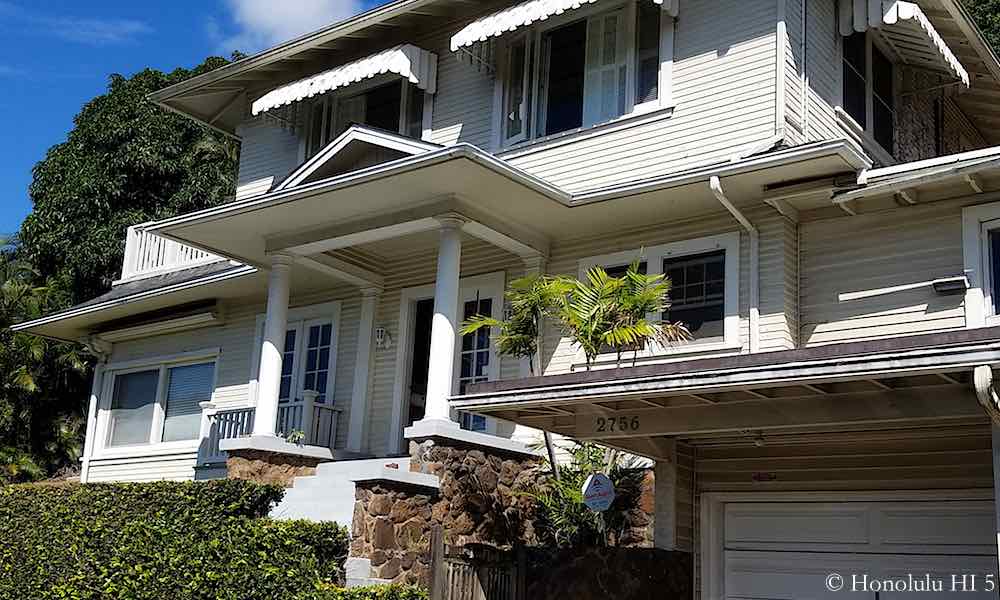
Pacific Heights had a rocky history in its initial years. The brainchild of a Charles Desky in 1899, he famously built an electric railway up the hillside to create interest and allow interested homebuyers to experience the views from the lands he was selling above Downtown Honolulu. The presence of a dance pavilion at the top added to the allure of the trip upward, but he ultimately sold few lots before being foreclosed on in 1901.
Not until 1921 would the project restart, the promise of utilities and the new prevalence of cars making it easier for residents to live up here as well as travel to and from the business center below. Many of Honolulu’s wealthier residents made homes here, building large luxury houses to match their status.
The examples that remain from the buildup of the 1920’s and 30’s are a wonderful variety of architectural styles, many of them European. It’s clear these were the products of people with both means and distinct individual tastes.
The residents in those first decades included, among others, one of the wealthiest families in Hawaii, the publisher of the Star Bulletin and a branch of a one of the local political powerhouses. Their residences all still stand today.
An excellent example of the European style can be seen in what was the mountain home of the Castle family, ½ of the Castle & Cooke powerhouse. Their Swiss chalet style house from 1928 was their retreat from town in the hotter months. The presence of such a prominent family confirmed Pacific Heights’ ability to attract the cream of Island society.
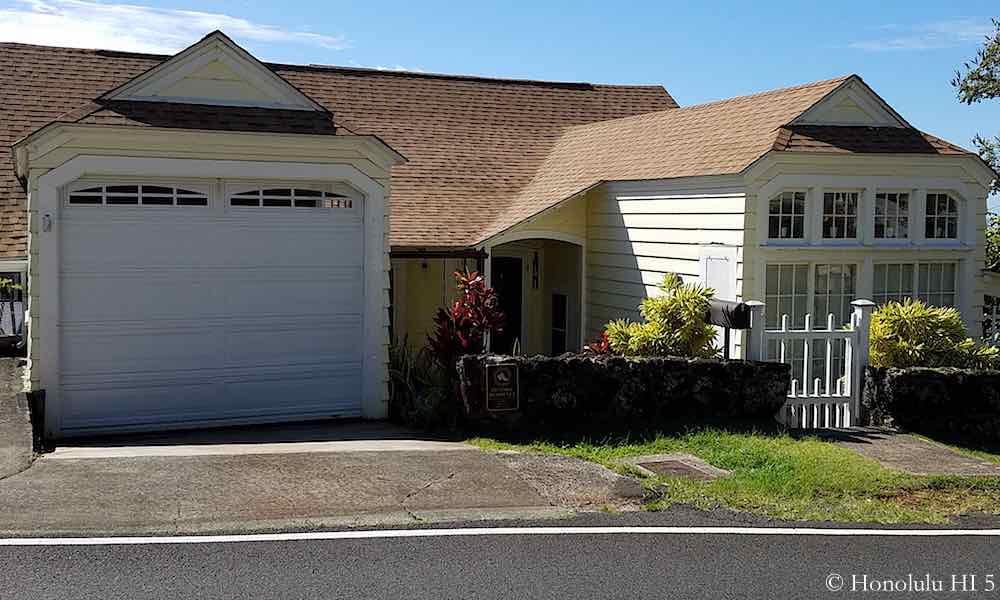
The same year saw the building of the Pratt house, a striking Late Victorian Queen Anne home complete with large turret and huge covered front lanai. This was one of the very first structures on the hillside, the original owners part of the extended Judd Family who sat in the highest Hawaii government offices from the Royal period into the Mid 20th Century.
The Star Bulletin in 1931 was a dominant opinion shaper and maker across Honolulu, and therefore Hawaii, so it fits that its editor had the ability to construct his Spanish Mission Revival house in this upscale neighborhood. Found at 3275 Pacific Heights Rd, what’s known as the Riley Allen Residence stunningly white walls are the mark of a man comfortable with attention.
Pacific Heights is still a place that has a cache and commands a higher price tag to have an address within it. For those interested in a place built for the cream of Honolulu’s society of the early 1900’s, it is an essential place to explore.
NUUANU, PALI & DOWSETT
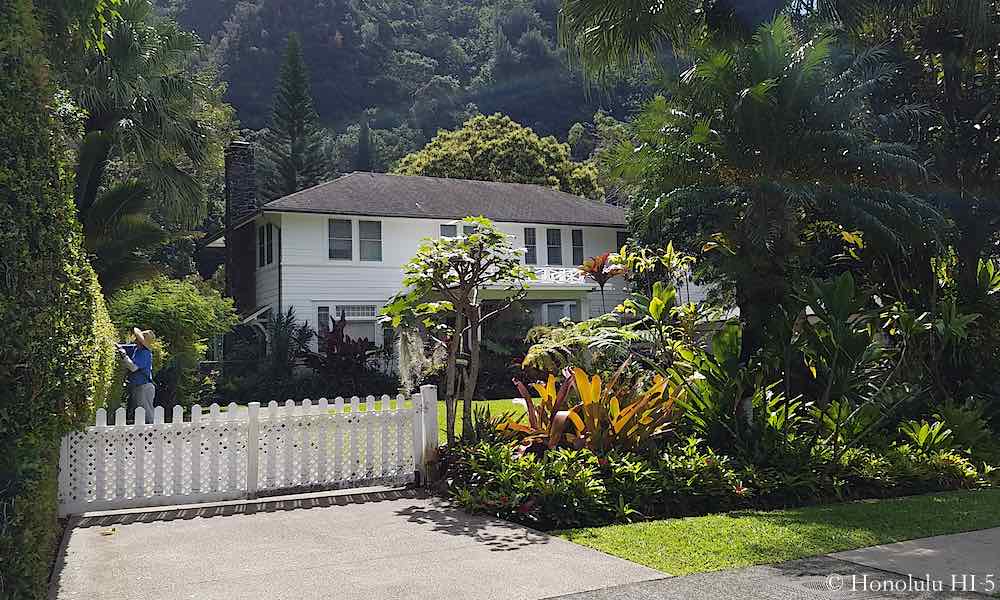
The Nuuanu, Pali & Dowsett neighborhoods have been prized Honolulu real estate for some time. The presence of Queen Emma’s Summer Palace is just the best known of the places that Hawaiian Royalty and their aristocratic class made their own here.
The movers and shakers of Honolulu followed suit, enjoying the cooler climes here and the deep green beauty of the lands, with the added benefits of being close to Downtown. What stands out unmistakably is how so many of the Historical homes draw their significance from not only the house itself, but the importance of the residents who lived in them.
The residence at 20 Old Pali Rd, for example, is an exceptionally well-preserved kamaaina home from 1900. It was once the home of Lucy K. Peabody and Edgar & Lucy Henrique, members of a High Ali’i family and descendants of one of Kamehameha’s top advisers.
The founder of Hawaii’s Democrat Party and a Chief Justice of the Hawaiian Supreme Court, James Coke, had CW Dickey design his Colonial Revival home at 3649 Nuuanu Pali Drive in 1934.
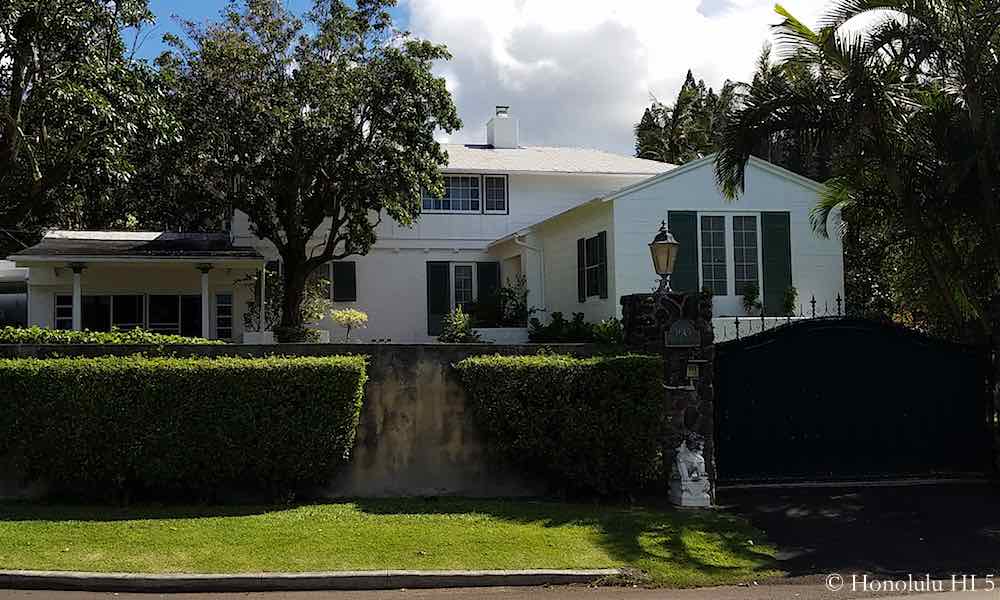
Even more impressive is the Spanish Colonial Revival structure built by Lihiwai Carter (51 Kepola Place), Hawaii’s Governor from 1903 – 1907. It was one of the biggest private residences ever built in Hawaii when it went up in the 1920’s, with 26 rooms. It still impresses today.
Governor Carter had a total of 10 acres of land surrounding his abode, reflecting the fact that this area was primarily one of estates at this time, rather than a real neighborhood. Few still remain in that form, as the lands were subdivided so the mansions that have survived preside over much smaller lots now. That shift took place in the 1960’s and afterward as the population surged.
Across these 3 communities, Nuuanu-Pali-Dowsett, the residences from the early 20th, and even late 19th in certain cases, tell a story from the very top of Hawaii’s society. It was a time when power and wealth were concentrated in fewer hands and their properties made it very clear who held it.
BLACK POINT
Black Point truly took off as a real estate goldmine in the 1930’s with Doris Duke’s building of Shangri La. Previously it had been home to a few smaller bungalow homes, constructed in the previous decade, some of which are still there almost a century later.
Despite the utterly entrancing scenery of the place, it was, for the time, on the far side from Downtown and off the beaten track. However, Duke’s masterpiece of a residence raised its profile and the possibilities for residences here that opened the floodgates of well financed homebuyers.
One was her good friend Duke Kahanamoku, whose home at 114 Royal Circle was built in 1937, about the same time Shangri La was completed. His house is there today, but was extensively remodeled in 2002, so it’s not exactly at it was when the Hawaiian Icon walked its halls.
Since that benchmark of the 1930’s many of the prominent, locally and worldwide, have lived in this small and ultra-exclusive community, such as Tom Selleck, Carol Burnett, Jim Nabors and Martin Denny, the Father of Exotica music.
The problem for those wanting to know, or even see, more noted Black Point residences is the protective cover over this place, due to its residents desire for privacy. For example, 4109 Black Point Rd is on the National Register of Historic Places, but there are no photographs online. The only information available seems to be that it is Tudor-French Norman style.
One we do have a window on is the John & Kate Kelly home at 4117 Black Point Rd. Designed by Louis E. Davis, it went up in 1931 as a single floor structure, then added a 2nd floor in 1939 that retained the Craftsman style. The upper story was primarily used as studio space for these two well known local artists. Their prints, paintings and sculptures centered around the Native Hawaiian people and culture and continue to be sought out widely today.
Though this is a secretive place, about its past as well as its present, there’s no question that there are incredible structures down here from the first half of the 1900’s that have much to tell. Built by some of the most talented architects and owners with the capabilities to indulge their dreams. As they say, ‘If these walls could talk’.
TANTALUS
Tantalus started life as one of the high ground retreats for the moneyed class, such as the Dillinghams, a place that afforded incredible views over Honolulu as well as lower temperatures that brought relief during the hotter seasons.
One of the very first substantial residences was the James A. Wilder Home (3935 Round Top Dr), an early Arts & Crafts style creation that dates from 1907. Along with its architecture and place in Tantalus’ residential history, the status of the Wilder family, which was at the forefront of Hawaii’s political and business worlds for decades, adds another level of importance.
These heights were also the scene of a pivotal part of Hawaii history. It came with the arrival of the Van Tassel family on this hilltop. Their home, called Nutridge, is a Colonial Revival designed by Hart Wood in 1925, which is enough for Historical designation, but not the pivotal event. That happened on their 22 acres of land surrounding it which held the first macadamia nut farm in Hawaii. From this property sprang an industry that grew to worldwide reach and fame.
The design highlight of this community, without a doubt, is the Liljestrand House (3300 Tantalus Dr), built in 1952 and the creation of Vladimir Ossipoff. It’s innovative modern design, with touches that acknowledge its Island setting, has earned it the label of ‘Hawaii’s Falling Water’. Both its exterior as well as its interior, including still remaining built-in furniture, have been featured in numerous magazines over the home’s lifetime. Still owned by the Liljestrand family today, plans are currently moving forward to open it up to the public for tours and study.
There are not a lot of homes up on this peak, but an unusual percentage have significance to them, from architectural as well as social standpoints. Many, though, cannot be seen from the road, with both artificial and natural cover often in place. Though frustrating for the observer, the residents like the ability to retreat and relax within that embrace and enjoy these homes that link them to an earlier Hawaii.
MAKIKI & MAKIKI HEIGHTS
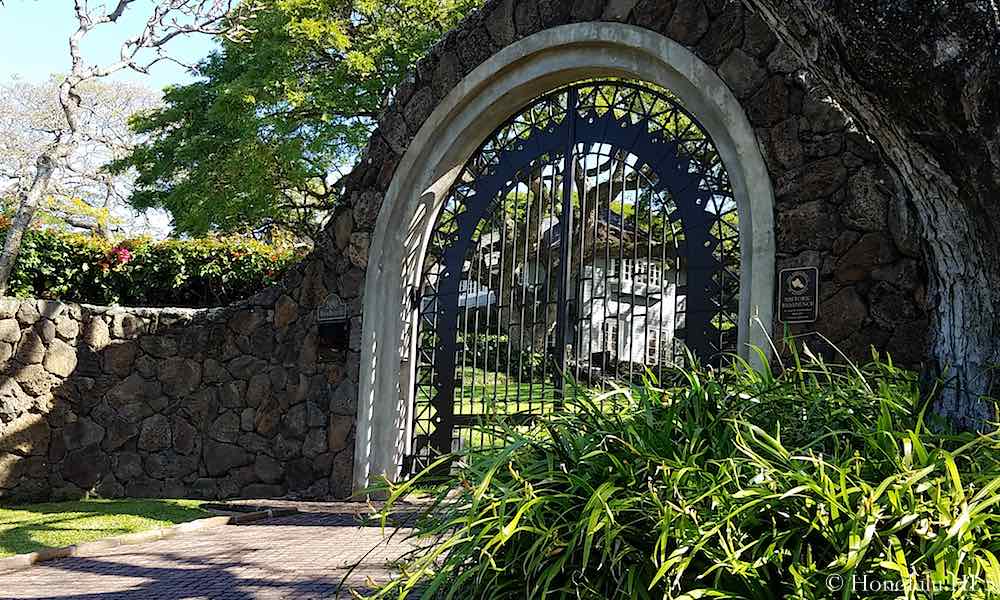
Makiki’s history is famously egalitarian. Unlike other Hawaii communities of the early 20th Century, the classes mixed here to a certain degree. Generally, though not exclusively, the western areas were middle and working class, known as a place many moved after finishing their work obligation on the plantations.
The eastern part, meanwhile, attracted mostly a wealthier class that fit a setting built around Punahou School, where the elite’s children attended. Still, there was crossover within.
It is a place where Bruno Mars grew up in a household that didn’t have a lot, yet was where exiled Philippines President Marcos lived in luxurious comfort after his ouster. Makiki has had range throughout its existence.
One perfect example of crossover is the Alfred Hocking house (1302 Nehoa St), located near Roosevelt High School. Here since 1904, it is undoubtedly the most striking Queen Anne house on Oahu. The stone walls and turret were the property of the man who was President of the Honolulu Brewing & Malting Company, as well as the Senator representing Maui during the Republic period. From the looks of his creation, the brewing business was good.
Closer to Punahou School, Makiki Street features a good share of the Historical residences in the lower areas of this district. #1619, the Mildred M. Yodor home, is the address of a 1929 Tudor Revival with as many as 30 windows in its facade. Up the road at #1921 is a 1930’s Mediterranean Revival, known as the Frandsen Residence, which won it special recognition for its arresting features that typify this style of the period.
In the midst of this upper class district, at 1955 Makiki St, you’ll still come across a small Hawaiian bungalow from 1938 that combines Western bungalow with pronounced Asian elements that show the emergence of Hawaii’s mixed cultures at this time in design.
Makiki Heights has bucked the general rule of this place, being primarily an address for the more moneyed class. That is reflected in the size and styles found here, as well as the names behind their creation.
A few examples – The Hugh G. Petersen, Jr. Residence (2345 Makiki Heights Drive), a Hawaiian Regional home from 1950 is the work of Vladimir Ossipoff. #2475 on the same street, Irvine Paris Residence, is yet another Hawaiian Regional example, this one from 1934. It is so well done and distinctive that it is believed to be a CW Dickey creation, though this is unconfirmed so far.
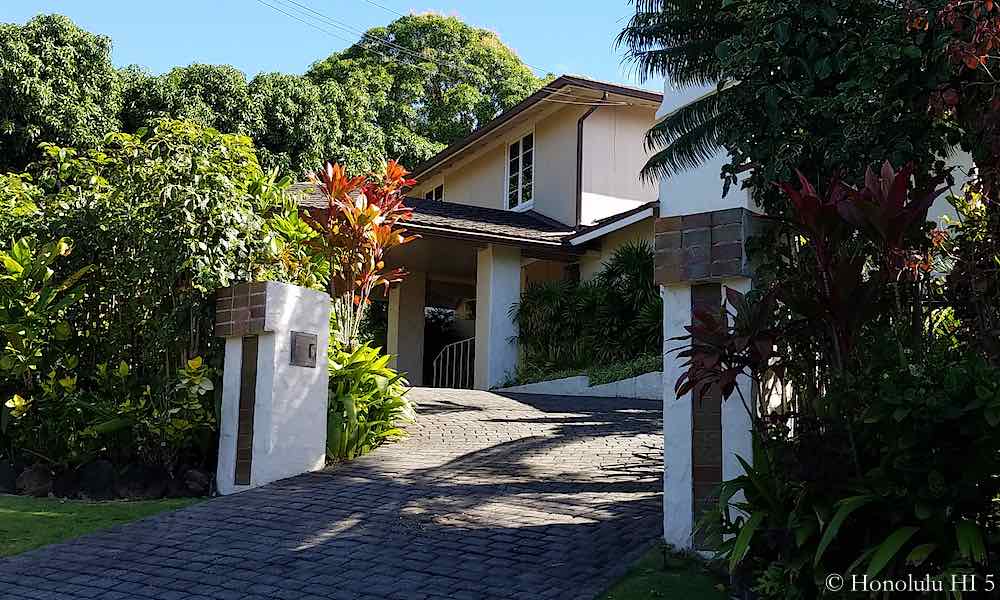
This rare company is possibly only bested by the Leong/Chun House (2721 Kolonahe Place), one of the very few residences in Hawaii from Alfred Preis, the architect best known for the Arizona Memorial.
Makiki isn’t often the first name to come to mind in a study like this one, but, like so much of Honolulu, those places can present the greatest rewards to those who take time to look more closely.
KAIMUKI & KAPAHULU
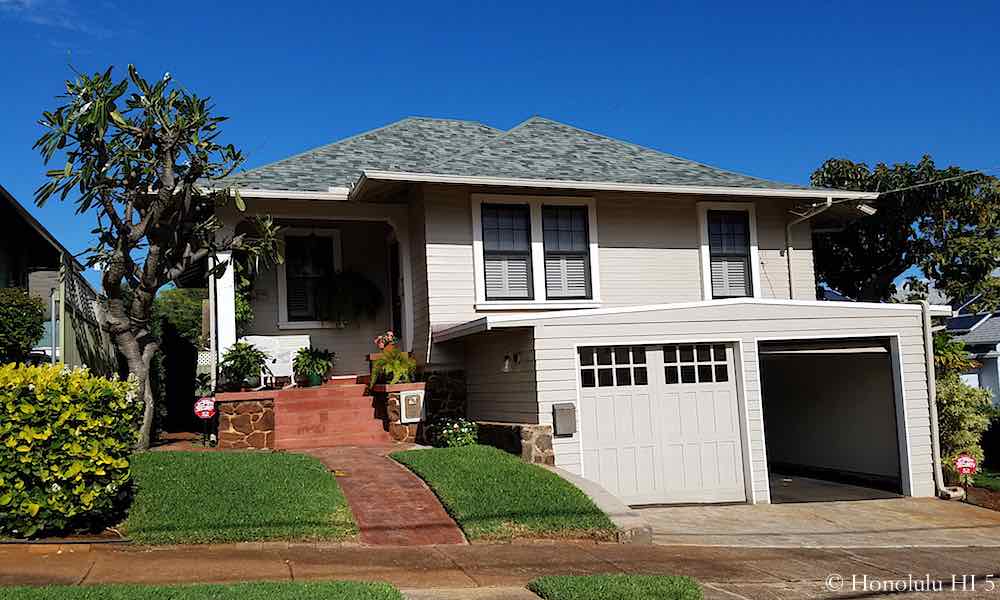
Kaimuki’s modern roots were as a new lower Middle Class neighborhood that first took form with the migration of Chinese families here after the 1900 Chinatown Fire, then filling out more fully with the arrival of the streetcar system.
Kapahulu followed a similar trajectory, the streetcars allowing a similar class of residents to escape the crowded Downtown conditions, yet still commute in for work. The initial forming, however, was partially due to businessman Charles Martin. His Midwest Rural Folk style home is well worth seeing at its 3528 Campbell Ave address. This 1898 addition to the land is the only example of this architecture in Hawaii.
Not far away from the Martin Residence, design enthusiasts will find a rare house custom created by Cyril W. Lemmon in the Lee Residence (917 12th Ave). Lemmon was an extremely successful local architect, noted for being one of the team responsible for the State Capitol’s groundbreaking building.
On the streets of Kapahulu, as well as Kaimuki, you’ll find numerous examples of Plantation homes and Hawaiian Bungalows, the most common choice of the people who first grew these communities.
Kapahulu’s Yee/Tom Court (3405, 3409A, and 3409B Wela Street, 3554 Trousseau Street), with its 4 houses collected around a common courtyard, has been singled out as a collection of classic Hawaiian Bungalow features, each one different. This group of residences is a reminder of the communal life that persisted outside the Plantations where it first originated.
These types of houses were where so many of the great Hawaiian entertainers of the Mid and Late 20th Century grew up. Kapahulu produced an embarrassment of riches in Hawaiian Music as the place where Emma Veary, Sonny Kamahele, Lani Guerrero, Nina Keali`iwahamana, John Pi`ilani Watkins and so many others grew up. From these small houses came huge talents.
Kaimuki has many wonderful bungalows from the first decades of the 1900’s, some recognized officially as historical, but some equally interesting that are not. However, we want to highlight some of the more unusual constructions outside that model.
One very significant entry in Kaimuki is the Albert ‘Sonny’ Cunha home at 1305 Center St. This large wooden house dates from 1926, the residence of the man who made Hapa Haole music a rage across the US in the early decades of the 20th Century. Along with being a musician and songwriter he represented Hawaii in Congress from 1923 to 1924. This grand structure fits the outsize life of its owner.
An even more prominent name is connected to the Lemon Wond Holt house (3704 Anuhea St). Its importance is linked first to the Holt Family, its members boasting many prominent businessmen and figures in the inner circle of Hawaii’s last two monarchs as well as the Territorial government. It’s status is just as important for its fantasy, picturesque style architecture that stands out strongly from its neighbors.
The variety of styles used in Kaimuki is underlined even further by the Lum Residence (840 15th Avenue), a 1926 Mediterranean Revival. Some call it a ‘modest’ example, but the details and flow of the structure deserve greater praise.
Both Kaimuki and Kapahulu were settled by working and middle class peoples of many cultures. Drive around these districts and you’ll see a rich variety of their homes, still lived in and treasured. It was, and is, a closely knit place, the people bound by an aspiring spirit and the fact that they dwell close together on these tightly laid out lots. What history has also recorded is that they were great places to call home, and still are today.
MANOA
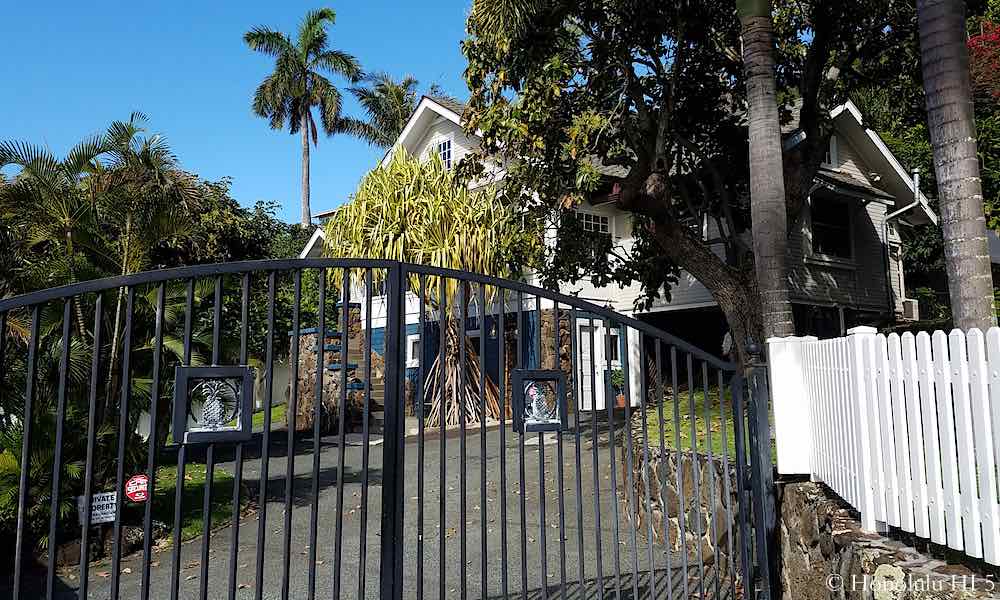
Without question, Manoa has the most recognized historic residences on Oahu. That isn’t hard to believe if you’ve ever ventured into the valley. Vintage homes line these roads, at times giving you the feeling of turning back the clock to Old Hawaii. Manoa was rivaled only by Kahala as the neighborhood of choice for the top Hawaii families in the first half of the 20th Century.
That privileged position is clear from the size and workmanship of the many houses from that era. The Cooke family had numerous residences here, 4 of which make the list, and all very close together. There’s Charles Montague Cooke Jr.’s Tudor Revival (1912) at 2859 Manoa Rd, another in the same style built by Charles and Edith Cooke Residence in 1928 at 2869 Manoa Rd, a 1962 Modern residence owned by Sam & Mary Cooke (2829 Manoa Rd) plus a relative outlier, Grace Cooke’s Craftsman home (1912), found at 2365 Oahu Ave.
For some, the greater attraction will be the home of architect Hart Wood (2512 Manoa Rd), which has many of the distinctive features he brought to his creations across Hawaii. For a time his design office was here as well, the site where many of his famous works came into being.
East Manoa Rd has many properties of import, including the Flora Lidgate at 2494, an example of Hawaiian style architecture from the mind of CW Dickey in his later period (1935). Something very different, but equally delightful, stands at 2627 East Manoa.
The 1929 Fantasy Picturesque creation there, in a Tudor Revival style, is known as the Earl R. and Lillian McGhee Residence. This architecturally unique building was built by the McGhees, one of the first Caucasian-Asian intermarriages in the Islands.
Ferdinand Ave is another of the streets where you’ll find a higher number of standouts. One you can’t miss is the August Christian Spoehler house at 2726. The arresting facade is primarily Gothic Revival, with some elements of Colonial Revival added. The intensely peaked gables cannot be missed.
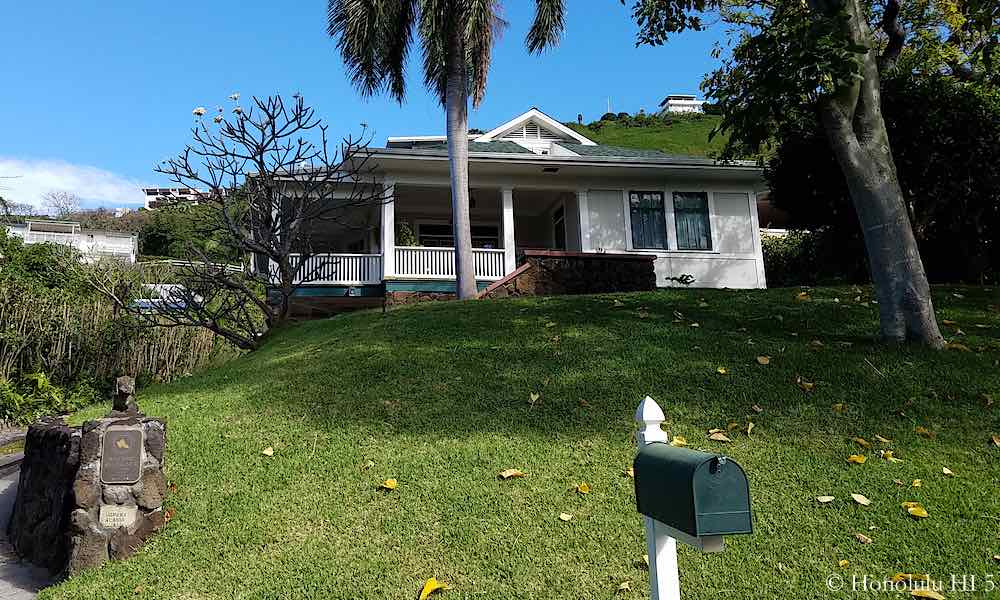
Overall, though, the most common pattern is the Craftsman style, which was prevalent in the 20’s and 30’s. A few examples are the Hatch Residence, a rare 3 story version of the Craftsman Bungalow (3255 Huelani Dr), the Stokes Young House (2618 Ferdinand Ave), which lays the Craftsman style over a Swiss Chalet form, and the Huelani Home (3162 Huelani Dr) where noted newspaper editor and radio newscaster Earl Welty lived.
There’s much more in this valley, from Mediterranean Revival to Japanese style, all part of this neighborhood that has held many of Hawaii’s most notable families, who built houses to match their own prominence, but never with the same blueprint.
DIAMOND HEAD
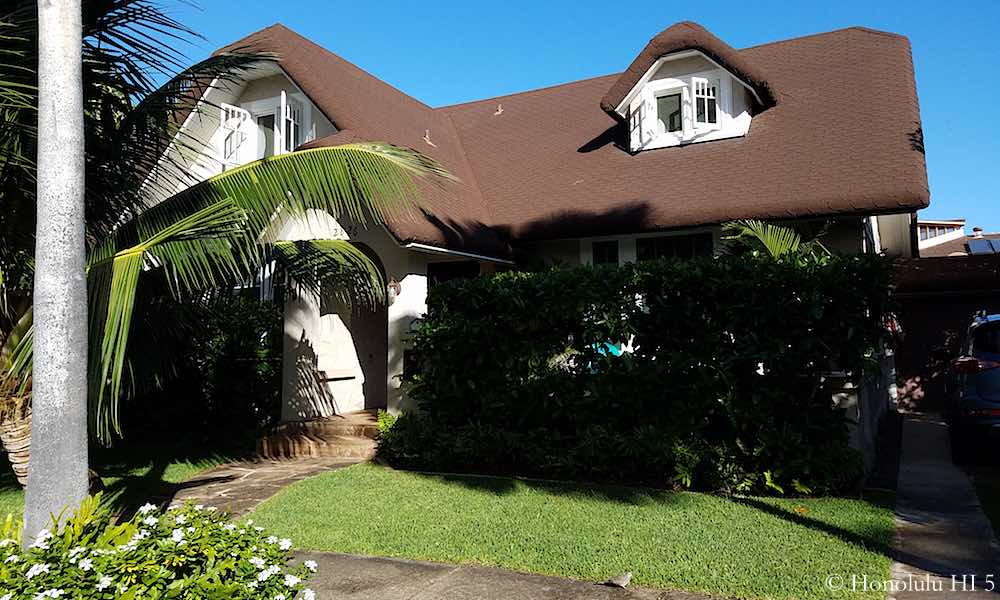
Diamond Head presents challenges for the anyone who loves to take in the significant sights of a neighborhood. Many of the addresses are hidden away behind gates & walls and the dwellings beneath Diamond Head Rd are mainly of more recent vintage. There’s good news, though.
Within the Gold Coast section of this longtime exclusive enclave are numerous stunning houses sitting right out in the open. Walk down Kalakaua Avenue just past Kapiolani Park and you’ll take in an immersive course in Honolulu residential architecture from the Early to Mid 20th Century, in almost every form it took.
At #3022 you’ll see a rare Spanish Colonial Revival cottage from 1926. Turn around to look directly across the street from there and you take in 2 rows of Tudor/French Norman charmers that demand a lingering look to fully enjoy. They’re something out of an old European village, but somehow fit perfectly here beside the roaring surf.
Back on the mauka side of Kalakaua, turn your attention next door at #3026, a Colonial Revival covered in shingles with high gabled roofs, added here in 1926. A few steps further east is its neighbor, a definitive Hawaiian bungalow created by possibly the most significant architect ever in Hawaii, C.W. Dickey. 2 doors down, you’ll pause to take in a Cotswald cottage (1929), one of the few examples on Oahu still standing from this era.
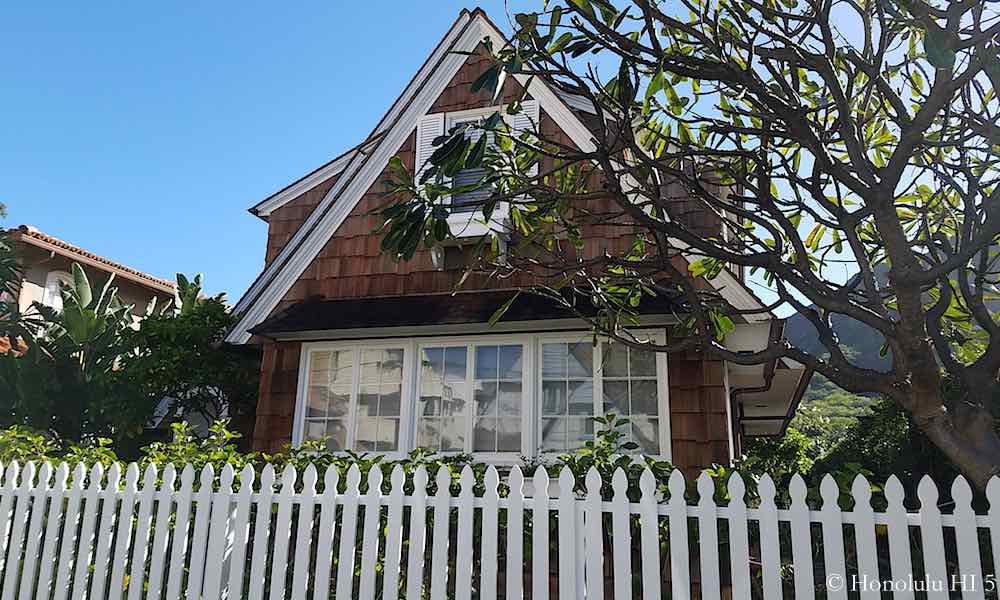
Stroll along this same little community on Kiele or Coconut Avenue and the riches multiply, including 3 Gingerbread houses from the 1920’s, in a more rounded style than those on Kalakaua, leading up to the corner of Coconut and Diamond Head Rd.
None of these structures are very large, the original lots being laid out in smaller dimensions, but the prime location beneath Diamond Head and next to the ocean have kept them consistently in demand, long before they were Historical.
This small pocket is an incredible display of the full range of Honolulu’s home styles from the 1920’s and 30’s, all lining just a very few blocks on the east side of Kapiolani Park. It’s a visual feast, just waiting there for you. No reservation needed.
HONOLULU’S RICH HISTORY, WRITTEN IN REAL ESTATE
Honolulu’s neighborhoods are much more than just towering condos or planned developments. Though that gets most of the press, there’s a deep and brilliant record of the Island’s past to be found. Thought not living history, it is history that can be lived in.

I’d like to discuss the mystery house at 4109 Black Point Road. And, I have a photo of it! John
Stumbled on 4604 Aukai in Kahala
while walking. Impossible to view
this historic home.